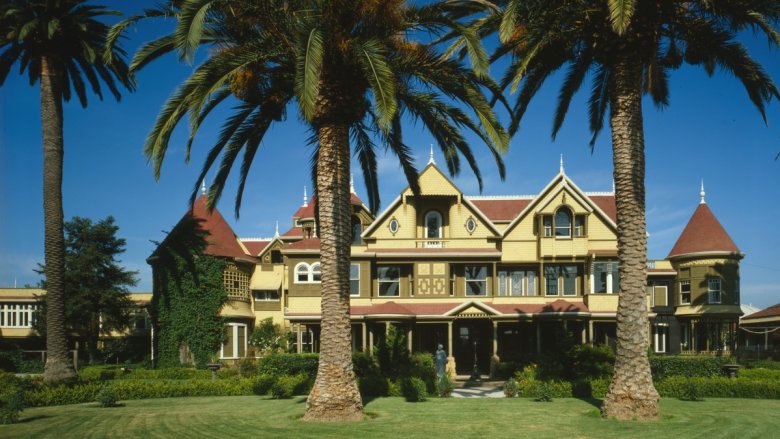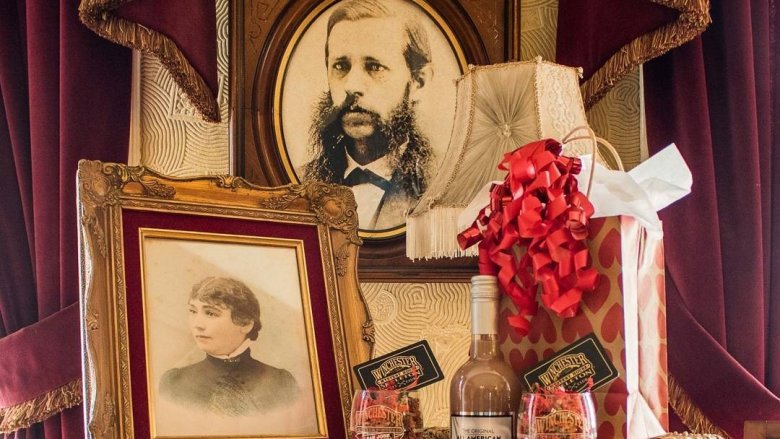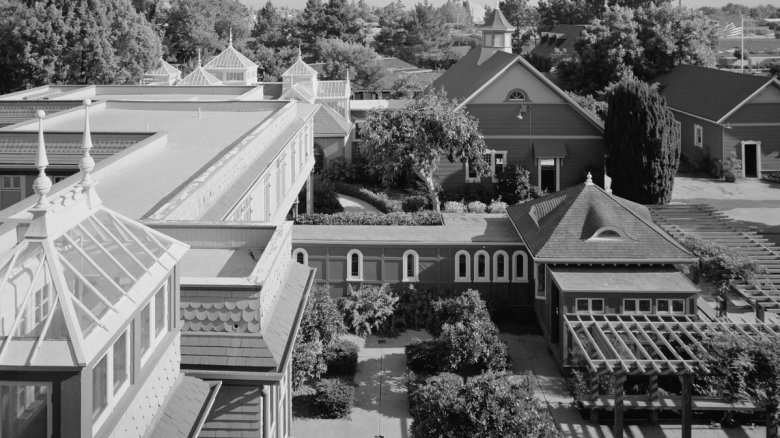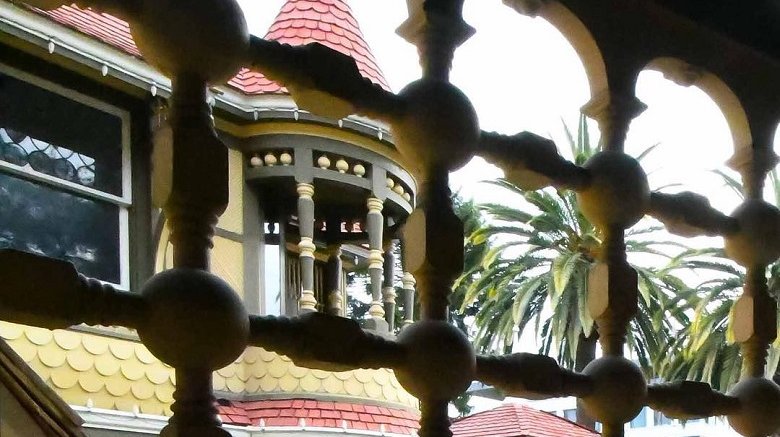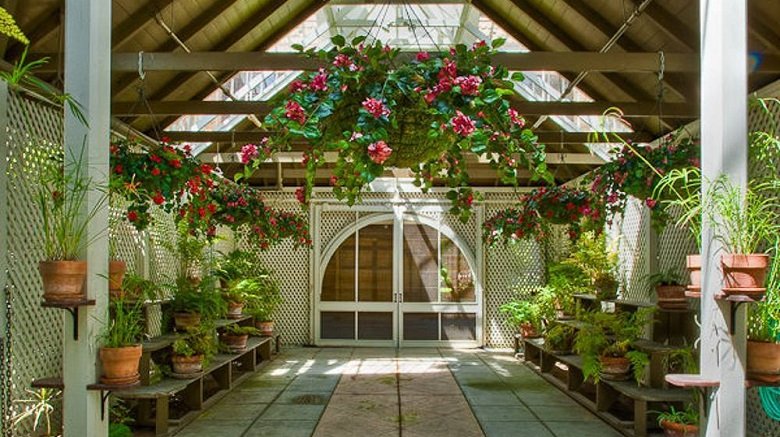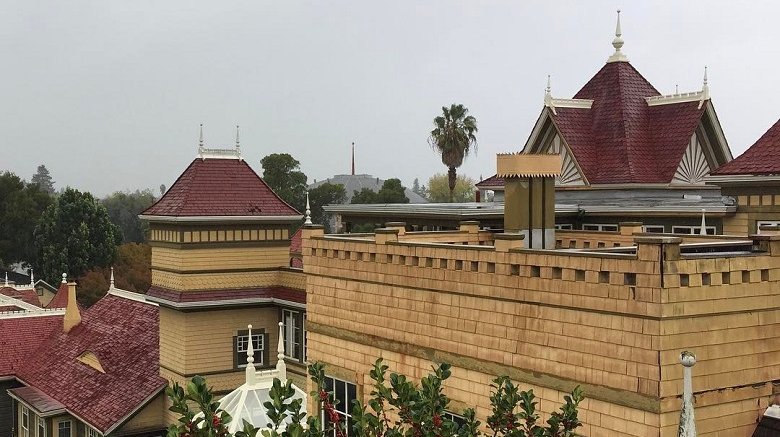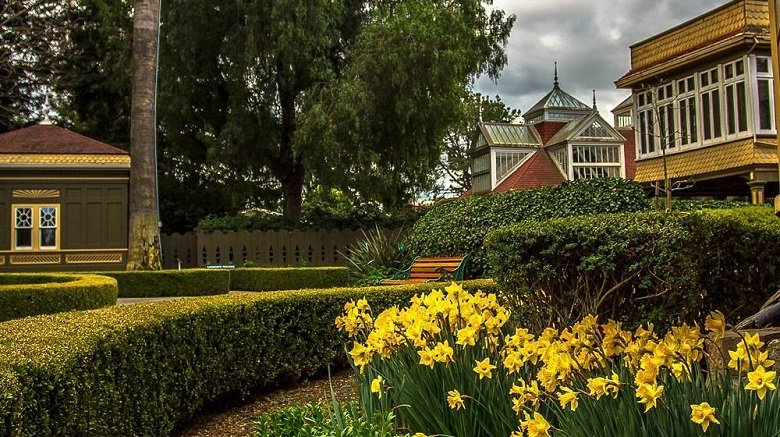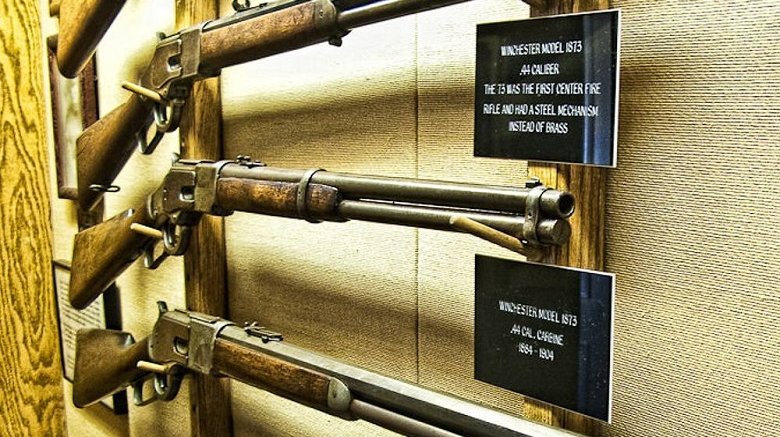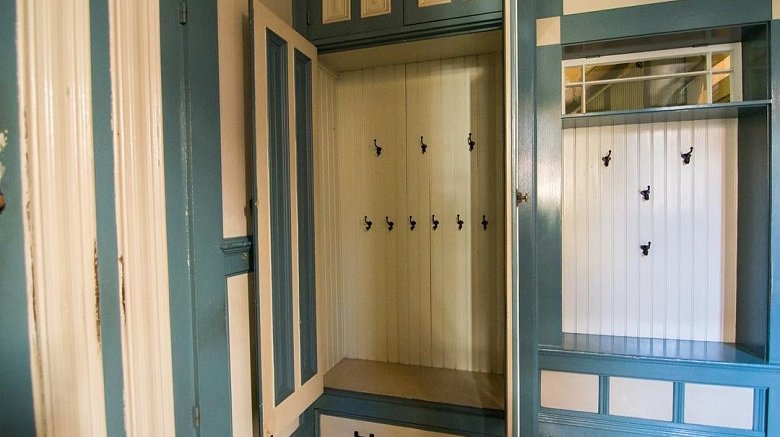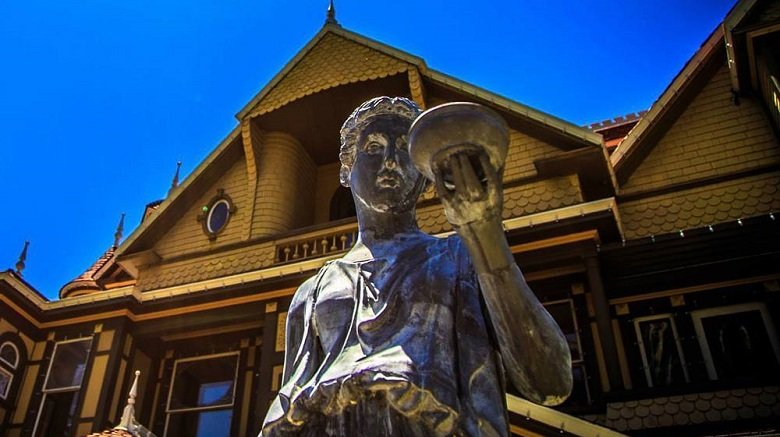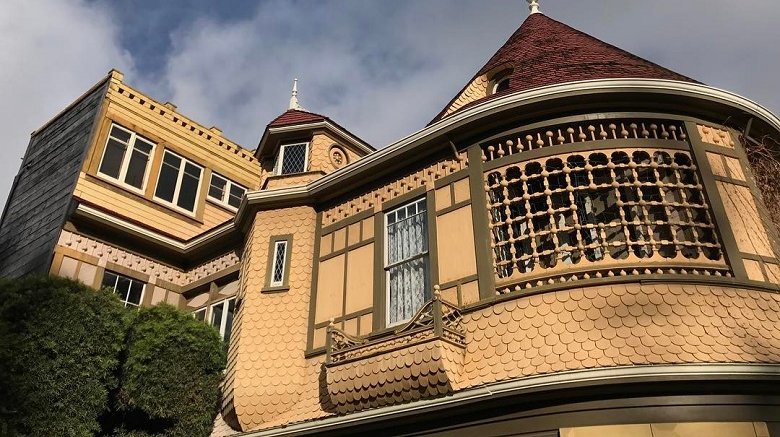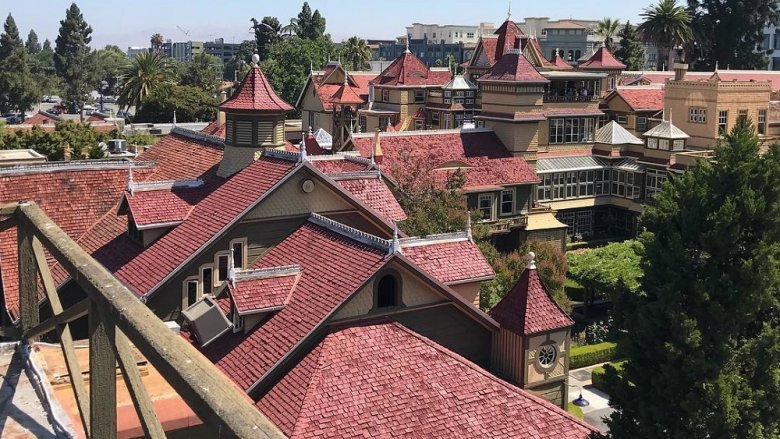The Untold Truth Of The Winchester Mystery House
We may receive a commission on purchases made from links.
There are more stories about the Winchester Mystery House than there are rooms, and it's easy to see why. At a glance, it's a labyrinth of dead-end hallways, rooms with false doors, staircases to nowhere, and no rhyme or reason whatsoever. Exploring the actual history of America's strangest mansion suggests the truth might be stranger than the fiction.
The Winchester story
The Winchester Mystery House was built by Sarah Winchester, who had married Winchester Repeating Arms Company heir William Wirt Winchester in 1862. Tragedy struck quickly when their only child, Annie, died in infancy in 1866. William took over the company in 1880 but died from tuberculosis the next year. At his death, she took his position in the company.
There are a few different versions of what happened next, but according to Destination America, the widely accepted one is that Winchester was plagued with grief over her lost family and was also haunted by the deaths their Winchester rifles had caused over the years. She turned to a psychic named Adam Coons, who allegedly told her to move west to build an ever-growing home for all the spirits of victims of Winchester victims. Others say she believed the never-ending construction was staving off her own death. According to author Pamela Haag, Ph.D. (via the Smithsonian), relatives later said she believed building was the only way she could keep the ghosts away.
Regardless, Sarah Winchester built the whole thing, employing 16 carpenters who worked in shifts to keep construction going 24 hours a day. It didn't stop until she died in 1922, succumbing to heart failure. Whatever her secrets and motivations were, they died with her.
It started out as an eight-room cottage
Writing in the Smithsonian, historian Pamela Haag says she became obsessed with the Winchester Mystery House and spent a good amount of time researching the actual history behind the stories. According to her, when Winchester first bought the property, it was nothing but acres and acres of orchards with an eight-room farmhouse nestled among all those trees.
When the house peaked, it had around 200 rooms, 47 fireplaces, 2,000 doors of various types, and 10,000 windows. It's tough to imagine a house that big, and apparently, it was tough for Winchester, too. By the time construction had been going for a while, she had completely forgotten which parts were the original house.
How about the elephant in the room? The cash. Sure, it's obvious the Winchester company would have been worth a fortune, but you don't know the half of it. You're probably working 40 or more hours a week just to pay your mortgage, but Winchester was financing her building project on a 50 percent stake in the company and, according to CSICOP, a daily salary of $1,000. If you had $1,000 a day to spend, you'd probably build a mystery house, too.
Hidden symbology, messages and optical illusions
Historian Pamela Haag says from the outside, the house looks impressive but not weird. Inside, it's a different story. Winchester didn't use blueprints to build; she just sketched out ideas on napkins and scrap paper. Most of the place just doesn't make sense. There are stairs to nowhere, chimneys that don't go all the way outside, balconies on the inside, rooms built inside rooms, and doors with nothing behind them.
But there's surreal beauty there, too. In one of the rooms, light and dark floorboards seem to change color when the sun hits them in a certain way. Stained-glass windows are inscribed with quotes from Shakespeare. The number 13 is hidden everywhere. According to Prairie Ghosts, most windows have 13 panes and most rooms have 13 windows. Staircases have 13 steps, walls have 13 panels, floors have 13 sections. CSICOP adds there are 13 coat hooks in the seance room, 13 drains in the sinks, and 13 stars in the leadlight window Winchester herself designed. She clearly didn't buy into all that nonsense about 13 being an unlucky number.
Some of the 'weird' design features are practical
Sure, the Winchester Mystery House might look like it was designed by a ferret tripping on LSD, but CSICOP says there are practical reasons behind some of the features. Maybe Sarah Winchester wasn't as batty as everyone thought. For example, a handful of staircases are only a few feet high and have wide steps that rise just a few inches. This seems nuts, unless you know Winchester was suffering from chronic arthritis at the time they were built. It's the same condition that explains the so-called "Room of Fires," built with a seemingly unnecessary number of heat sources. (Seven.) That was used as a sauna and helped her arthritis. Some of the doors look absurdly tiny, but Winchester was only 4' 10", and servants can duck.
There are iron bars on some of the interior windows, but those were once exterior windows. Someone worth $1,000 a day can't have too many bars on her windows. How about a reason for the doors to nowhere? Some of them actually have peepholes that Winchester used to spy on her staff. She paid the construction workers three times their standard wage, but we all know what greed does to people. Any funny business and they'd be fired on the spot. What a practical woman.
It was massively damaged in the 1906 earthquake
At 5:12 a.m. on April 18, 1906, the San Francisco Bay Area was rocked by a major earthquake. By the time the dust settled, around 3,000 people were dead and 225,000 (according to the USGS, more than half the city's population) were homeless. The Winchester Mystery House didn't escape, and photos from just before the earthquake show it standing an impressive seven stories. According to Jake Williams, marketing coordinator for the house today, the biggest casualty of the earthquake was the massive tower that rose from the center of the house. Partial collapse left it dangerously unstable, and it was torn down. It's thought most of the materials were reused elsewhere, but the tower itself was never rebuilt.
It's possible all the stories are rumors
There's no denying Sarah Winchester was witness to some heartbreaking personal tragedy, and from a storytelling point of view, a widow haunted by the ghosts of her family's fortune is a pretty darn good one. But according to Mary Jo Ignoffo's book Captive of the Labyrinth, all the stories are nothing more than a marketing gimmick to drum up interest in tours and the property in general, fueled by the rumors spawned by jealous neighbors (via The Mercury News).
She goes as far as suggesting there was never any psychic, that Winchester dismissed construction crews for months at a time, and that she may have used the endless turmoil of building as a reason to turn away visitors. Tracing the story through letters, scrapbooks, and the journals of the workers who built the house, Ignoffo says there was another motivation behind the constant building: providing jobs. Winchester's father was a woodworker who had struggled to keep a job, and Ignoffo suggests she wanted to keep as many craftsmen employed as she could. She also says most of the claims about Winchester and the house are complete bunk, that Winchester's reclusive nature was partially due to the constant pain of her arthritis, and that the house was more hobby than obsession. Well, at least there's no doubt about which makes the better story.
Her constant building may have been sabotage
There's another theory about Winchester's motivations that has everything to do with revenge and nothing to do with the supernatural. According to io9's Annalee Newitz and her research for the California American Studies Association Annual Meeting, what's rarely mentioned in Winchester Mystery House history is that Winchester was only partial heir to the company. The company president was her brother-in-law, William Converse, and he essentially pushed her out of any and all company decisions. She headed west, while the leaders of the Winchester Repeating Arms Company flailed about to try to continue the success of their mass-produced rifles.
Viewed through that lens, perhaps Sarah Winchester started building her house to throw away the family fortune. Instead of pouring her profits back into the company, she funneled them into her house, as an admittedly brilliant way to give her relatives the financial middle finger from across the country. It's not far-fetched, especially considering negotiations to sell the company started the same year she died and were completed in 1931.
What went on in the Seance Room
It's called the Seance Room or the Blue Room, but it's pretty weird either way. There's one entrance but three exits, including a door that leads to a 10-foot drop into the kitchen and another that opens up into a small sink. According to popular lore, Sarah Winchester retreated to the room every night between midnight and 2 a.m., and no one else was allowed in. What went on there? No one's sure, but everyone has a story.
According to one tale, Winchester went there to commune with spirits and learn what they wanted her workmen to build the next day. Others say she was reaching out to those who met a grisly end at the barrel of a Winchester rifle, while still others say she spent time talking to her husband.
The research done by Annalee Newitz suggested something different. Perhaps Winchester was really using those hours to spy on the help with a series of hidden windows. There's also the possibility Winchester believed in spirits and used her time to figure out how to invite the good spirits in and keep the bad ones out. Decades later, no one knows what went on in that room for two hours every night.
There are some awesome ghost stories
You don't need to believe in ghosts to appreciate a great ghost story. According to Winchester Mystery House employees (via The Mercury News), it's still home to some active spirits including a dark-haired man seen pushing a wheelbarrow through the halls or stopping to repair things. Workers have reported being touched and shoved by invisible hands, and one tour guide is even sure she's seen Sarah Winchester herself heaving a perturbed sigh after finding a tour group in her bedroom. To be fair, that would be annoying.
One of the strangest places in the house is the South Turret Witch's Cap, where guides claim Harry Houdini once held a seance. Tour guide Jamie Foster told The Mercury News she was in the turret when she felt someone embrace her from behind and begin to dance ... so she danced. Maybe ghosts like a little YA paranormal romance, too.
A new room was found in 2016, and more rooms opened in 2017
In 2016, the Winchester Mystery House announced it had found a new room. According to the statement reported by ABC News, it was an attic room Winchester had boarded up after the 1906 earthquake. The story goes that she was convinced the earthquake was caused by angry spirits, so she had them sealed away. The room was a perfect time capsule, furnished with an organ, couch, dress forms, sewing machine, and paintings.
How unlikely was the find? The house had been open for tours for around 90 years at that point, so pretty unlikely. In 2017, The Mercury News reported a new general manager overhauled the way things are done there, opening 40 more rooms to the public, including unfinished spaces and cubbyholes created by the haphazard construction. There may still be secrets lurking in the house, which is awesome because a world without secrets waiting to be discovered is a world you don't want to live in.
She had a heartbreaking secret vault
Most of what we know — or think we know — about Sarah Winchester, her home, and her motivations is pure speculation. One thing we do know is that her house was built on grief.
One of the rooms is a ballroom, and in the middle of the room stands a door. When Winchester was alive, the door was always locked and she always carried the key. After her death, the staff took the key and opened the door. There was a vault inside, so they opened that, too (via CSICOP).
There was another vault, like the most depressing — and never funny — gift-wrapping job ever. When they opened the innermost of the five vaults, they found a treasure unlike any they were probably expecting. There was a lock of her husband's hair, a lock of her daughter's hair, and their obituaries. Whatever Sarah Winchester's deepest secrets were, maybe her sense of loss was what truly haunted her.
